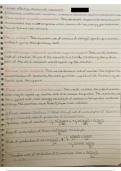Samenvatting alle hoorcolleges Introduction to Cognitive Behavioural Therapies
Hoorcollege 1 – Introduction to cognitive behavioural therapies
What is CBT?
Empirically based form of treatment, departing from theoretical models on learning
and information processing.
History of CBT (in short)
Late 1950’s – 1960’s – onward: 1st generation
Behaviour therapy (observable behaviours; classical and operant conditioning,
behavioural interventions like exposure). Pioneer: B.F. Skinner.
Early 1970’s – 1980’s – onward: 2nd generation
Cognitive therapy (information processing; negative automatic thoughts, the
socratic dialogue, cognitive restructuring’. Pioneer: Aaron T. Beck.
Integrated during 80’s into
Cognitive-behavioural therapy.
2000’s onward: third generation
Mindfulness Based Cognitive Therapy (MBCT). Based of MBSR Kabatt-Zinn.
Acceptance and Commitment Therapy (ACT)
Dialectal Behaviour Therapy (DBT)
Nowadays referred to as
Cognitive-behavioural therapy
Characteristics of CBT
Focus on present
Question is: why does the problem persist?
Focus on thoughts, behaviours, emotions
Time-limited
Goal oriented
Problem solving approach
Building on theoretical and clinical research
Central in CBT: Think, Feel and Behave (interconnected). CBT Triad.
Structure of CBT
1. Validation of patients complaints
2. Building therapeutic relationship/engagement
3. Explaining general treatment rationale
4. Cognitive and behavioural assessment
5. Formulating realistic goals
6. Designing treatment plan
7. Carrying out treatment plan
8. Broadening to other areas of dysfunctioning
9. Relapse prevention
Once the intervention shows effect, the client starts trusting the therapist more (therapeutic
relationship).
1
,Cognitive And Behavioural Assessment
Aim
To investigate the exact nature of this patient’s thoughts and behaviours.
Initial approach
Formal assessment using interview, self monitoring, etc.
Maintenance
Assesses the nature and impact of cognitions and behaviours continuously during
treatment phase and also in interaction with the patient (Assessment never stops).
Definitions
Behavioral therapy: applying experimentally verified learning principles.
Behavior: logical response to a meaningful situation.
Behavior is the result of a complex information system with antecedent and
consequent factors (ABC).
Learning: acquiring knowledge about the connection between events (= expectations) can
result in a behavioral change.
Learning model: abnormal behavior is achieved by the same learning processes as normal
behaviour: the ways of developing, maintaining and changing behavior are the same.
Normal or abnormal?
Deficit or excess (frequency, intensity, duration, inappropriate situation)?
Norm: general norm, impairment, health-related risk, illegal.
Conclusions for CBT interventions
Importance of
Clear procedure
Established effectiveness (functional relationship)
Empirical evidence of supposed mechanism of change (CBT: embedded in learning
theory or in information processing, etc.)
Status of CBT
Treatment of choice for many disorders (Guidelines for Mental Health).
Important treatment option for many disorders (anxiety, depression, psychosis, skills
training in autism, work related problems, relation problems, etc.).
Attractive, because short-term, complaint-driven and measurable effects.
Therapist drift
CBT is not perfect
According to the disorder, about 50-60% who start the treatment reach recovery.
In well-conducted studies.
Efficacy and effectiveness.
So how might we improve our empirically-supported treatments?
Efficacy ideal situation/experimental situation/controlled condition.
Effectiveness real world situation.
2
,Therapists’ beliefs and attitudes
We rarely use manuals and we dislike them
Even though using them results in better outcomes for patients
Many clinicians have no idea what a manual is
We believe the therapeutic alliance will do lots of the work for us
1. How much of clinical outcome is associated with the alliance?
Clinician beliefs = 32%
The evidence = 4-5%
2. Does the alliance drive therapy outcome?
Not in CBT
Important to focus on early behavioural change
So why does this matter?
CBT is not perfect.
But when we drift, we underperform on what it could deliver to our patients.
And that means that people suffer
What is the best thing that we could do right now?
Develop new therapies?
Deliver the existing ones appropriately?
Let’s start with the red zone…
What is the best indicator of therapist drift?
Our clinical outcomes in everyday practice.
Therapy drift not doing what your supposed to do.
Number of years practicing has influence on the drift. So your clinical outcomes go
down with the years that you’re practicing.
Your own experience can be of (negative) influence.
Behavioural therapy (BT)
Basis principles of BT – interaction of person with his/her environment
Antecedents of behaviour conditions or stimuli that set the occasion for behaviour
to occur.
Behaviour anything a person does (or not does).
Consequences effect that behaviour produces (immediate & delayed).
Assessment
Intake evaluation: assessing problem behaviour (behavioural excesses/deficits),
coping behaviour.
Registration of problem behaviour and antecedents/consequences (typically in BT) or
thought records (typically in CT).
Functional analysis.
3
, Functional analysis – antecedents
Discriminative stimuli (Sd)
Events or situations that elicit the behaviour and predict reinforcement or
punishment.
Establishing operations (EO)
Factors changing the reinforcing or punishing properties or other
environmental events.
E.g.: hunger, thirst, craving, negative mood, thoughts, rules (e.g. if-then
statements).
Motivational factors
S-delta are situations or circumstances in which the behaviour does NOT take place.
Example functional analysis; Problematic drinking:
Cognitive Therapy (CT)
Basic principles of CT
Thoughts (or cognitions) give meaning to a neutral stimulus and determine feelings
and behaviours.
Beliefs or schema’s are developed through (childhood) experiences and form a filter.
Identify thoughts.
Distinguish between automatic thoughts, (intermediate) beliefs, and core beliefs.
Challenge and change thoughts (from maladaptive to adaptive).
Analyses in CBT on different levels
Most specific (movie-like).
Topographical analyses (chain of behaviors).
On the level of problem behavior
Functional analysis in BT (describing antecedents (Sd/EO) – behaviour –
positive and negative consequences).
Cognitive conceptualization in CT (core belief, beliefs, situation, automatic
thoughts, reactions (emotional, physiological, behavioural).
On the level of an overview of (multiple) problem areas and their interactions/causal
relations.
Case formulation / Holistic theory.
4






